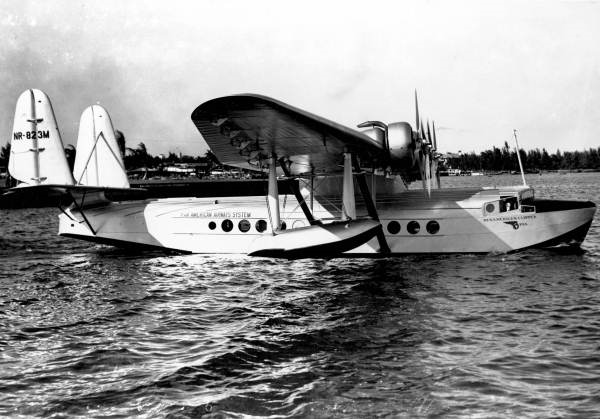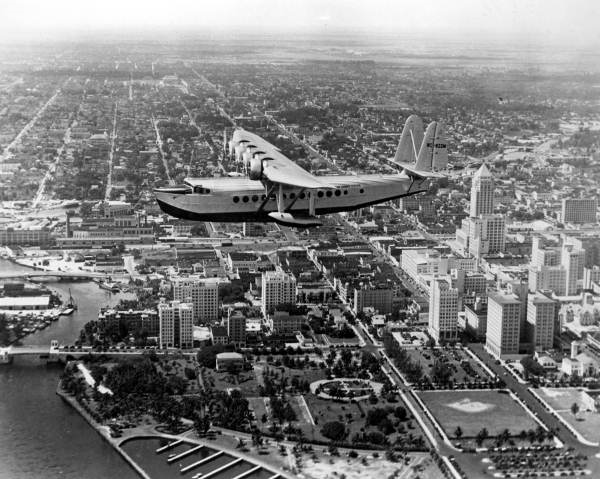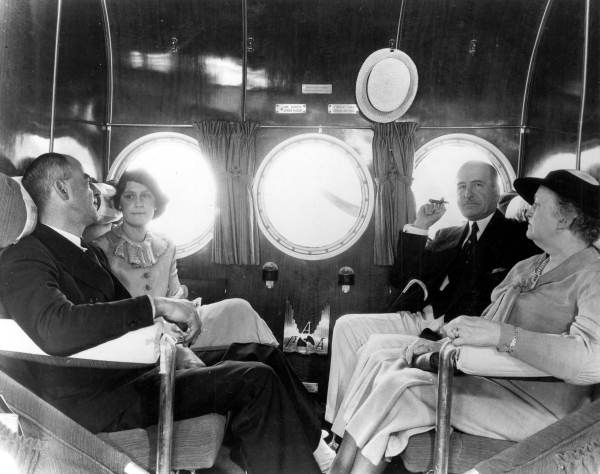The Golden Years and Technology – Part Three – The Clippers of Pan Am – July 28, 2023

The Golden Years and Technology – Part Two – The Douglas Airliners – July 21, 2023
July 21, 2023
The Golden Years and Technology – Part Four – Pan Am – The Rest of The Story – August 4, 2023
August 4, 2023RN3DB
July 28, 2023
Good Morning,
It’s Friday again, and I am continuing with the series on the airplanes that made commercial aviation possible. This week it is my favorite airplanes of all time—the flying boats. However, because there is so much good information out there on Pan Am and the Clippers, I chose to copy verbatim certain articles and gave credit to each source used. As always I would like all aviators to connect with their roots and one of the ways they can do that is by using the “RN3DB” as a resource.
Enjoy…..
The Clippers of Pan Am
The history of Pan American Airways is inextricably linked to the expansive vision and singular effort of one man – Juan Trippe. An avid flying enthusiast and pilot Trippe, only 28 years old when he founded the airline, lined up wealthy investors and powerful government officials from his personal acquaintances in the high-society of the 1920s. However, Pan Am’s first flight was an inauspicious start to its epic saga.
In 1927, facing a Post Office deadline for the commencement of mail carriage, Pan Am had no working equipment for its sole airmail contract between Key West and Havana. Fortunately for Pan Am, a pilot with his Fairchild seaplane arrived at Key West and was willing to carry the mail to Cuba for the start up operation.
Pan Am’s fortunes took a turn for the better in the fall of 1927. Through the heavy lobbying efforts of Juan Trippe, Pan Am was selected by the United States government to be its “chosen instrument” for overseas operations. Pan Am would enjoy a near monopoly on international routes. Pan Am added lines serving Mexico, Central America, the Dominican Republic and Haiti. Most of these destinations were port cities, which could be reached only by landing on water so Pan Am made good use of its “flying boats,” the Sikorsky S-38 and S-40. Flights were eventually expanded to serve much of South America.
Just a few years later, Pan Am launched its effort to cross the world’s largest oceans. Survey flights across the Pacific were conducted with the Sikorsky S-42 in 1935, but passenger service required bigger and better aircraft. Accompanied by much fanfare, the Martin M-130 was introduced in 1936, followed by the Boeing 314 in 1939. Known as Pan Am Clippers, these mammoth flying boats flew from San Francisco harbor skipping across the Pacific with stops at Hawaii, Midway Island, Wake Island, Guam, the Philippines and then Hong Kong. Advance teams had prepared the stopover islands by blasting coral to make safe coves for sea landings and constructing luxury hotels for Pan Am’s discerning, rich clientele. Next on the Pan Am list for conquest was the world’s other major ocean – the Atlantic.The Boeing 314 entered European service in 1939 flying from New York to Lisbon and Marseille by way of the Azores.

http://www.pbs.org/kcet/chasingthesun/companies/panam.html
Boeing 314
As airplane travel became popular during the mid-1930s, passengers wanted to fly across the ocean, so Pan American Airlines asked for a long-range, four-engine flying boat. In response, Boeing developed the Model 314, nicknamed the “Clipper” after the great oceangoing sailing ships.
The Clipper used the wings and engine nacelles of the giant Boeing XB-15 bomber on the flying boat’s towering, whale-shaped body. The installation of new Wright 1,500 horsepower Double Cyclone engines eliminated the lack of power that handicapped the XB-15. With a nose similar to that of the modern 747, the Clipper was the “jumbo” airplane of its time.
The Model 314 had a 3,500-mile range and made the first scheduled trans-Atlantic flight June 28, 1939. By the year’s end, Clippers were routinely flying across the Pacific. Clipper passengers looked down at the sea from large windows and enjoyed the comforts of dressing rooms, a dining salon that could be turned into a lounge, and a bridal suite. The Clipper’s 74 seats converted into 40 bunks for overnight travelers. Four-star hotels catered gourmet meals served from its galley.
Boeing built 12 Model 314s between 1938 and 1941. At the outbreak of World War II, the Clipper was drafted into service to ferry materials and personnel. Few other aircraft of the day could meet the wartime distance and load requirements. President Franklin D. Roosevelt traveled by Boeing Clipper to meet with Winston Churchill at the Casablanca conference in 1943. On the way home, President Roosevelt celebrated his birthday in the flying boat’s dining room.

http://www.boeing.com/boeing/history/boeing/m314.page
Sikorsky S-42
The Sikorsky S-40 had laid the groundwork for Pan Am’s Latin American route system, but Pan Am was never fully satisfied with its compromise design,. Even before the S-40 first entered service, Pan Am technical adviser Charles Lindbergh was developing specifications for a streamlined airliner that could truly span the oceans and fulfill Pan Am’s intercontinental ambitions.
Two aircraft manufacturers made credible bids for Pan American’s next airliner. Igor Sikorsky wanted the chance to build improve the S-40, whose limitations he fully understood, and Glenn Martin wanted to expand his business from military to commercial aircraft. To hedge his bets against either company’s possible failure, and to stimulate competition, so that Pan Am would not be overly dependent on any one firm, Juan Trippe accepted both bids and ordered three planes from each company. On October 1, 1932, Pan Am placed a firm order for three S-42 aircraft, with an option for seven additional planes.

http://www.clipperflyingboats.com/pan-am/sikorsky-s42
Martin M-130
Even before the first Sikorsky S-40 entered service in 1931, it was obvious that the plane — which Charles Lindbergh called a flying forest — would not provide the performance necessary to fulfill Pan Am’s ambitions. Consequently, the airline began searching a streamlined airliner that could truly span the oceans. Two manufacturers wanted the job. Igor Sikorsky wanted a chance to improve on his own S-40, and Glenn Martin wanted to establish his company in the commercial aviation business. Juan Trippe ordered planes from both.
The driving force behind Pan Am’s specifications for a new plane was Andre Priester, the Dutch immigrant who had worked for KLM and who became Pan Am’s detail-obsessed chief engineer. Charles Lindbergh, who had been so deeply involved with Pan Am’s earlier designs, had just undergone the trauma of his son’s kidnapping and murder on March 1, 1932, and was only minimally involved with the plans for the new clipper.
Pan Am wanted a plane that could fly 3,000 miles (long enough to reach Europe or Hawaii) while carrying a payload equal to its own weight, and the Glenn L. Martin Aircraft Company designed a plane that met the airline’s needs. Although the first Martin M-130 was delivered over a year behind schedule, and its $417,200 cost was almost twice that of the Sikorsky S-42 (and more than five times the $78,000 price of the leading airliner of the day, the Douglas DC-2), the M-130 had the speed, size, and range to carry mail and passengers profitably across the Pacific or Atlantic.
The first M-130, named China Clipper, was delivered to Pan American on October 9, 1935, just two days after its first test flight. A little more than a month later, on November 22, 1935, China Clipper left San Francisco on the first scheduled mail flight across the Pacific ocean.
http://www.clipperflyingboats.com/pan-am/martin-m130
Next week we will finish our series up by highlighting the Boeing-707 but before we leave the Clippers behind I thought you should know that Gene Rodenberry, creator of Star Trek, was a Clipper pilot. So, until then take some time to look back, connect with your past and remember as an aviator you are a “Gatekeeper of the Third Dimension.”
Protect your profession, your future and the future of your fellow aviators.
Robert Novell
July 28, 2023
PS. The rest of the page has a few pictures of Clippers. These were borrowed from Holcomb’s Aerodrome located at www.airminded.net Great website for all of us aviation enthusiast–take a look.




